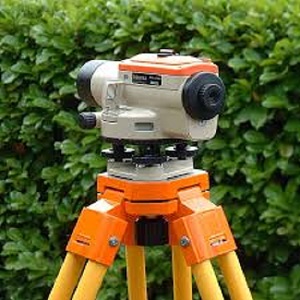Rise and fall method
The rise and fall method is a technique used in surveying to determine the difference in elevation between two points. It is commonly used in design and construction to create accurate site plans.
A levelling instrument such as a dumpy level or a theodolite is set up at one point (the benchmark) and a staff is placed at a point whose elevation is to be determined. The instrument is then sighted on the staff and the vertical distance between the instrument and the staff is measured. This is known as the backsight.
The staff is then moved to the next point and the instrument is sighted on the staff again. The vertical distance between the instrument and the staff is measured once more, and this is known as the foresight.
If the foresight is higher than the backsight, it means that the point being surveyed is higher than the benchmark. The difference between the foresight and the backsight is known as the rise. If the foresight is lower than the backsight, it means that the point being surveyed is lower than the benchmark. The difference between the backsight and the foresight is known as the fall.
The process is repeated for multiple points, with the rise and fall measurements being added and subtracted as appropriate.
[edit] Related articles on Designing Buildings
Featured articles and news
Editor's broadbrush view on forms of electrical heating in context.
The pace of heating change; BSRIA market intelligence
Electric Dreams, Boiler Realities.
New President of ECA announced
Ruth Devine MBE becomes the 112th President of the Electrical Contractors Association.
New CIAT Professional Standards Competency Framework
Supercedes the 2019 Professional Standards Framework from 1 May 2025.
Difficult Sites: Architecture Against the Odds
Free exhibition at the RIBA Architecture Gallery until 31 May.
PPN 021: Payment Spot Checks in Public Sub-Contracts
Published following consultation and influence from ECA.
Designing Buildings reaches 20,000 articles
We take a look back at some of the stranger contributions.
Lessons learned from other industries.
The Buildings of the Malting Industry. Book review.
Conserving places with climate resilience in mind.
Combating burnout.
The 5 elements of seiri, seiton, seiso, seiketsu and shitsuke.
Shading for housing, a design guide
A look back at embedding a new culture of shading.
The Architectural Technology Awards
The AT Awards 2025 are open for entries!
ECA Blueprint for Electrification
The 'mosaic of interconnected challenges' and how to deliver the UK’s Transition to Clean Power.
Grenfell Tower Principal Contractor Award notice
Tower repair and maintenance contractor announced as demolition contractor.
























Comments
[edit] To make a comment about this article, or to suggest changes, click 'Add a comment' above. Separate your comments from any existing comments by inserting a horizontal line.